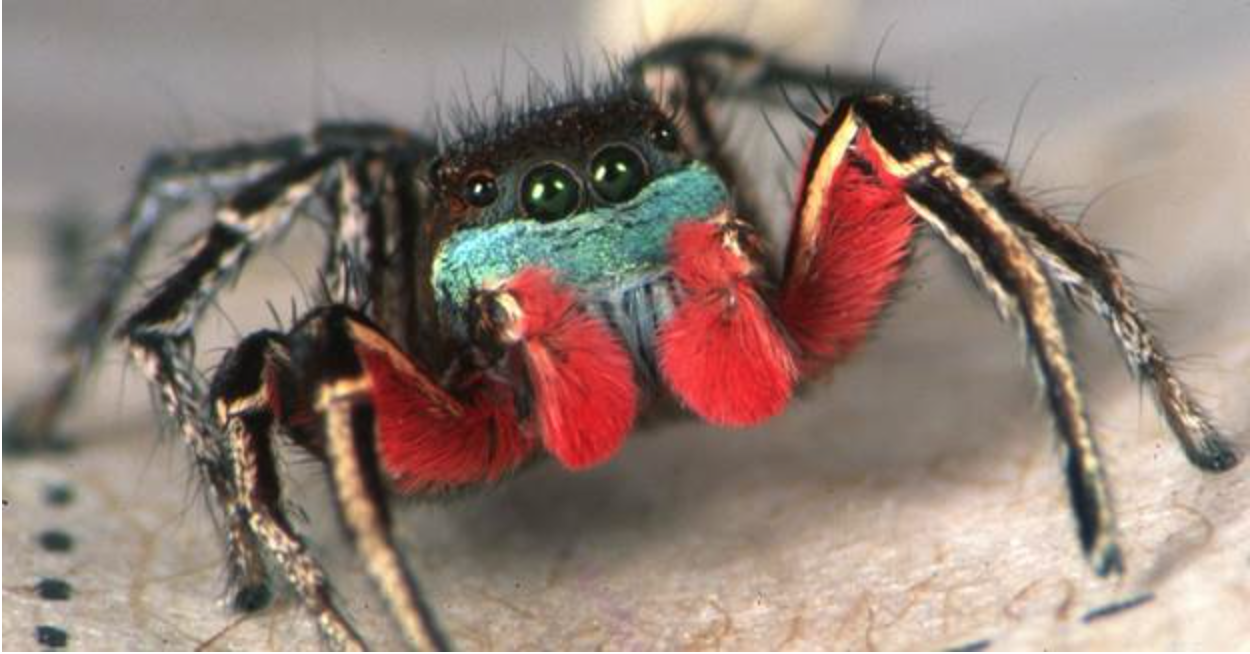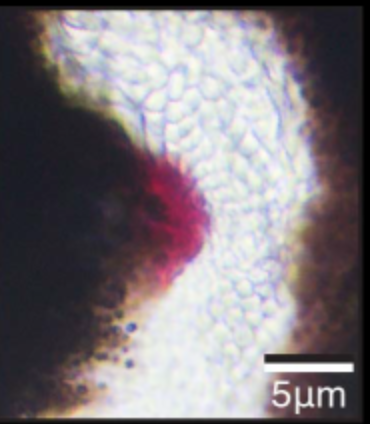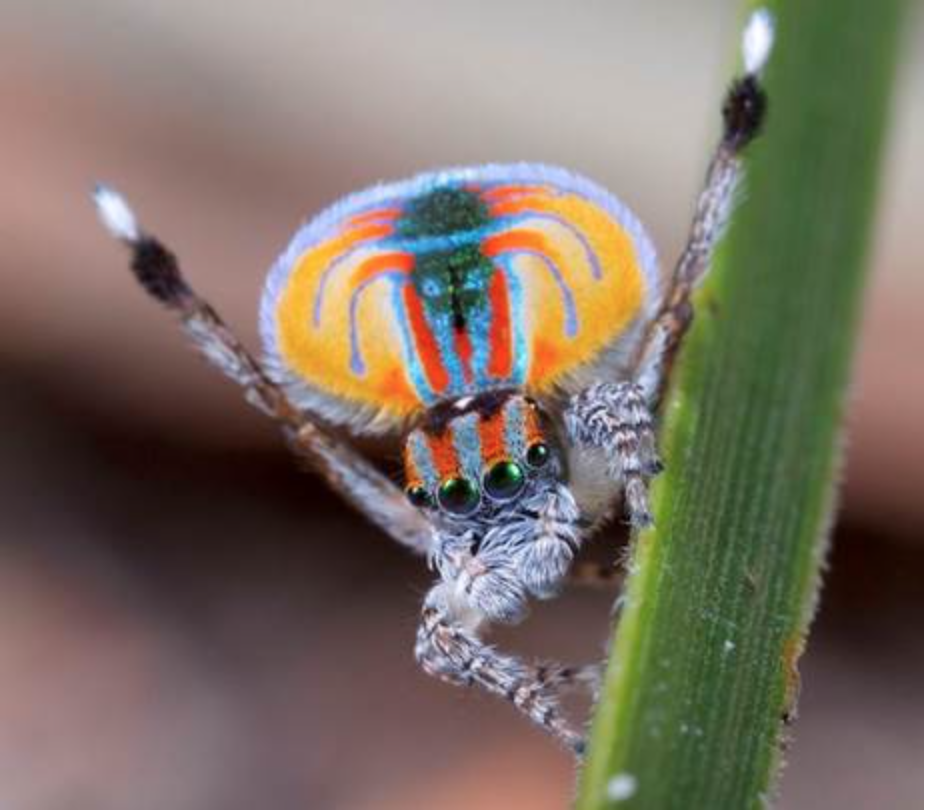By Dina Navon
In a classic thought experiment, evolutionary biologist Stephen Jay Gould asked: if you rewound the tape of life, erasing everything that has happened, and stopped somewhere in the past to let life run anew, would the second iteration look anything like the original? In other words – just how predictable is evolution? New research on color vision in jumping spiders may shed light on the answer.
It’s a research story that is itself “full of serendipity,” admits Dr. Nathan Morehouse, the lead investigator on the project, who presented this work at the January 2017 meeting of the Society for Integrative & Comparative Biology. Morehouse, a researcher at the University of Pittsburgh, chatted animatedly with me about a week after the meeting. Quick to laughter, his demeanor consistently conveyed a youthful sense of wonder for the natural world and an enthusiasm for scientific practice.

Kismet first struck when a post-doctoral researcher in Morehouse’s lab, Dr. Lisa Taylor, began studying the use of color in mating and foraging in the colorful jumping spider genus, Habronattus. Most previous studies on color vision in jumping spiders suggested that, like deer, they could not distinguish between red and green, though the color patterns on their bodies included bright reds and oranges.
Taylor showed that on sunny days or under bright laboratory lights, Habronattus spiders could be trained to develop either preferences or aversions to red food. Because the animals’ color vision apparently depended on the light conditions, Taylor and Morehouse decided to conduct behavioral experiments only under bright lighting. Had the initial trials taken place only in the field or under dim lighting, they may have (falsely) concluded that Habronattus could not see long-wavelength colors like red, orange, and yellow. But with the bright light conditions, Taylor and Morehouse discovered they clearly could.
“We didn’t have any framework for understanding how they might see those colors,” Morehouse says, so he contacted Dr. Tom Cronin at the University of Maryland Baltimore County. Dr. Cronin has expertise in a technique called micro-spectrophotometry (MSP), which determines the types of light absorbed by a tissue sample, such as crustacean retinas. Every material interacts with light in a characteristic way – it absorbs, transmits, and reflects specific wavelengths of light. MSP allows researchers to quantify and record that unique pattern of absorption, transmission, and reflection for a given material. Different cells in the retina of an eye absorb different wavelengths of light, allowing the brain to “see” the color that corresponds to that wavelength. MSP can reveal which retinal cells absorb a particular color.
“You do this [technique] in a dark room, under dim red light, and we were in there for days and days and days…and all we’re finding is UV and green cells,” recalls Morehouse. They pored over slide after slide, each slide containing a slice of tissue from a single spider’s eye, finding only cells that absorbed green and UV wavelengths, but seeing none that would absorb red. Frustrated, with less than two days before they were scheduled to leave Cronin’s lab, Cronin came to check on their progress—and the second instance of serendipity.
Thinking outside the box, desperate for an answer, Cronin turned on the white light under the scope. Normally, you would avoid using white light because it will bleach out the retinas, destroying the very thing you are trying to understand. With the white light on, however, Cronin noticed a bright red dot on the retina, and called the others over to have a look.

“You don’t know if it’s an anomaly – if it’s some weird thing about that particular animal,” Morehouse admits. They began sorting through all their slides, looking for a similar red spot in the other samples, and sure enough, every individual had a red dot in at least one of its slides. “We hadn’t noticed it because we’re working under a red light and a red filter”, and under those conditions it just didn’t show up. “If Tom hadn’t shown up and had the hunch that he should flick on the white light, or if it hadn’t been one of the sections of retina that had the filter, then we might have walked away scratching our heads, not understanding it, and either never solved it or solved it far, far later.”
The red filter – that red dot you can see on the retina – actually absorbs green light, stopping it before it can reach the green-sensitive photoreceptors behind it. The subset of green photoreceptors that are blocked by the red filter therefore only receive red light, which allows the spiders to distinguish between green and red. This mechanism is “a subtractive way of getting color-vision”, Morehouse says. You’re throwing away most of the signal in order to add another color to your repertoire.
How can Habronattus afford to lose so much information about the world? It turns out that they primarily live in open, light-filled habitats, where light isn’t necessarily a limiting resource. Dr. Taylor’s original behavioral data actually support this conclusion – after all, the spiders’ sensitivity to color depended heavily on the lighting conditions! Test an animal on a cloudy day, and it would not appear to have color vision. This subtractive method of color vision is known to occur in other animals, like birds and reptiles, but it’s the first known instance in spiders.
Other spiders appear to see red, including another genus of jumping spiders called Moratus. Morehouse next asked whether the mechanisms of color vision in these two different, but closely related, groups were the same – does Moratus also have this red filter? Based on the MSP work in those animals, Morehouse concluded that they do not. And there, he suggests, is the “broader serendipity” of the story.
Both Moratus and Habronattus have UV and green absorbing cells – as do most other jumping spiders. Those cells are markedly similar across species and likely existed in the common ancestor of all jumping spiders. But Moratus spiders see red very differently from Habronattus. Had Morehouse’s group started with Moratus, he states, they might “never have suspected that there was another mechanism of color vision in these animals.” They just happened to start with Habronattus color vision, found an unusual mechanism to explain it, and, naturally, wondered whether there were other origins of color vision in other jumping spiders. Kismet, again.

Morehouse suggests that Moratus likely evolved color vision due to a duplication in the genes that produce opsins, light-sensitive proteins that enable cells to be photoreceptive. Cells with opsins use the protein to convert photons of light into electrochemical signals, which are read by the brain and converted into vision. Having two opsin genes allows one of the copies to evolve, as its original function can be maintained by the other copy. Changing the structure of the opsin can change the wavelength at which it is activated, which in turn changes the color sensitivity of the underlying photoreceptor. Random gene duplication and subsequent divergence is a common theme in evolution, and opsin duplication and divergence has likely played a role in the evolution of color vision in many groups, including mammals. Morehouse’s lab has now shifted focus to sequencing the opsin genes in Moratus, in search of that duplication event.
So, is evolution predictable? Broadly speaking, it seems like there are many paths to a similar place, and which one you take depends on your biology and ecology, as well as random chance. “It’s always a balance between happenstance–randomness–and predictability”, Morehouse suggests. Even the process of research follows that ebb and flow of chance and procedure. Scientific investigators see something weird by chance, and their natural curiosity is piqued so they just have to understand it using the most reliable of tools, the scientific method. In this instance, the data itself showed a similar pattern of coincidence and predictability – human enterprise acting as a mirror for Mother Nature.

